Jul 19, 2010 | history, other, personal
Very few publications can trace its roots back to colonial times. One of those publications is The Saturday Evening Post. The Post was founded as The Universal Instructor of Arts and Sciences by a Samuel Keimer. Keimer moved to Philadelphia from New York after failing to secure work. He rented space from Hugh Meredith who printed the paper. The paper was not exactly successful and was ridiculed by Benjamin Franklin in The Mercury using the pseudonym “Busy Body.” After nine months, Keimer sold the paper to Franklin and Meredith on October 2, 1729.
The new partnership changed the title of paper to The Pennsylvania Gazette and Franklin began to edit the paper into a more readable half-sheet (half of a broadsheet) that was published twice per week. After a few weeks the work load forced Franklin change it to a weekly publication.
Franklin and Meredith dissolved their partnership on July 14, 1730. Franklin continued to publish The Pennsylvania Gazette as the paper’s sole publisher until he made David Hall a partner in 1748. Hall had been working for Franklin and writing for The Pennsylvania Gazette for five years prior to becoming a partner.
By 1765, Franklin and Hall dissolved their partnership. By May 1766, Hall partnered with William Sellers to continue publishing The Pennsylvania Gazette. Following Hall’s death in 1772, his sons William Hall and David Hall, Jr., continued in their father’s place.
The partnership of the Hall brothers and Sellers continued in William Sellers died in 1804. Shortly after Seller’s death, William transferred his partnership to David, Jr. who continued publishing The Pennsylvania Gazette. In 1810, David Hall, Jr. partnered with George W. Pierie until the partnership dissolved in 1815. Hall partnered with Samuel C. Atkinson until Hall died on May 27, 1821.
Following Hall’s death, Atkinson partnered with Charles Alexander. Alexander was a business partner of Atkinson in other ventures. Atkinson and Alexander decided that the paper needed a new character to keep readers interested and capture new readers. They revamped the paper and on August 4, 1821, debuted the first edition of The Saturday Evening Post. The new paper included weekly news stories but included poetry and short stories from contributors like Edgar Allan Poe, Harriet Beecher Stowe, James Fenimore Cooper, and many other famous authors.
Through the 19th century, The Saturday Evening Post changed hands several time until it was purchased by Curtis Publishing in 1897. Curtis Publishing brought the paper to a new level especially when it hired a 22-year old artist named Norman Rockwell in 1916. During the 1940s, 1950s, and 1960s Rockwell was joined by N.C. Wyeth, J. C. Leyendecker, John Clymer, and John E. Sheridan to create some of the most memorable cover illustrations in history.
Curtis Publishing stopped publishing The Post in 1969 after losing a defamation case (Curtis Publishing Co. v. Butts, 388 U.S. 130 (1967)) and ordered to pay $3 million in damages.
The Saturday Evening Post was revived in 1971 as a quarterly publication with an additional focus on the coverage of heath issues and disease prevention. In 1978, ownership was transferred to the non-profit Saturday Evening Post Society who continues to publish The Post as a bi-monthly publication.
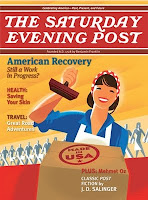 Through this long history, The Saturday Evening Post continues to publish a variety of stories including those of general interest. One of The Post’s regular columns is “Collectible News & Notes.” As part of the column, The Post features a collector and their passion for what they collect. In the July/August 2010 issue (Vol. 283, No. 4), your blog host is the featured collector.
Through this long history, The Saturday Evening Post continues to publish a variety of stories including those of general interest. One of The Post’s regular columns is “Collectible News & Notes.” As part of the column, The Post features a collector and their passion for what they collect. In the July/August 2010 issue (Vol. 283, No. 4), your blog host is the featured collector.
I was contacted via email by the writer of the article. After we exchanged a few notes, he called me one afternoon. I happened to have been driving to a local grocery store when he called. I spent most of our one-and-a-half hour conversation while sitting in the parking lot in front of the grocery store. It was a pleasant conversation and I am sure I gave him more information than he asked for. He distilled the conversation into a nice article that appears on one page—even though there is a minor mistake (in the caption under the picture, it should say that I am still looking for a 1909-S VDB Lincoln Cent in change).
Two weeks after our discussion, a local freelance photographer visited my home to photograph me and my coins. The photographer was a pleasant woman who also took pictures of my dogs. My wife liked the pictures that appear in the magazine.
It might be difficult to find a copy of The Post on newsstands. The magazine has a higher subscription circulation than from newsstands. You might find a copy in a bookstore that has a large magazine section. Otherwise, it should appear on their website in a few months.
The Saturday Evening Post dates back to Benjamin Franklin. It has featured great authors, artists, and other Americans. Now, I am part of that history. How cool is that!
Cover image courtesy of The Saturday Evening Post.
Sep 7, 2009 | personal
This post has only tangential mentions of numismatics. If you will indulge me on this occasion I promise to continue writing about various numismatic topics during this week. Thank you.
As we go through life, we lose perspective as to how much our parents had influenced our lives until something forces us to think about it. Since my mother’s passing on August 27, I have been thinking about how her influence has affected me and maybe what I write about on this blog.
Although my mother was not a direct influence in my early entry into coin collecting but she never discouraged me. I remember finding an early 20th century Indian Head Cent in the money I collected for delivering Newsday in the early 1970s. The first person I showed this coin to was my mother, who was cooking dinner at the time. Although the coin did say “United States of America,” she did not know about the coin. I had to wait for my father to come home, but we talked about the coin all evening.
As I grew up, there was the usual parent-child tension that built up that was outgrown as I matured. But she was always supportive of whatever I did as long as I met my responsibilities, such as school or work, without criticism. She was so concerned about me that she would not let me get my driver’s license until I passed her driving test. She finally allowed me to take the driving test two weeks after my 16th birthday which I passed without issue.
My mother started painting and drawing as a teenager and stopped while she had three children, which I am the oldest. She went back to painting in the late 1960s. I remember watching her set up her easel in the kitchen and paint. Later, when her youngest child went to college, she went back to school to earn a Bachelors of Fine Arts. Of course she graduate with honors (Cum Laude).
My mom was diagnosed with Lupus 15 years ago and worked as long as she could doing and teaching flower arranging until her hands couldn’t handle the cutting. She was told to stop oil painting, acrylics, and the polymer clay because of the fumes were effecting her lungs. So she took up watercolors, colored pencils, and charcoal. When her hands were not as steady, she worked on a computer and whatever else she could do.
During her ups and downs, I would buy craft kits, colored pencil kits, books on alternative arts, and send them to her for inspiration. Sometimes it worked. Sometimes her health would not let her do much.
After my first wife died, I found my old blue coin folders and the folders I purchased for the 50 State Quarters and decided to dive back into collecting. My mother, who was feeling better at the time, encouraged me to pursue this outlet. We began to encourage each other to pursue our interests.

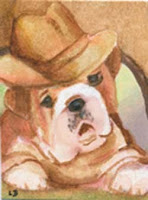 Over the last few years, my mother participated with Art Cards Editions and Originals (ACEO). Art cards are 3½ by 2½ inch works of art that are sold and traded. Art cards were a great outlet for someone who loved art but could not do larger work. I know she bought cards with themes she liked and cards from others who were also being challenged by illnesses. She was also ecstatic when one of her images were chosen for the group’s cookbook. She bought a copy of the cookbook for me.
Over the last few years, my mother participated with Art Cards Editions and Originals (ACEO). Art cards are 3½ by 2½ inch works of art that are sold and traded. Art cards were a great outlet for someone who loved art but could not do larger work. I know she bought cards with themes she liked and cards from others who were also being challenged by illnesses. She was also ecstatic when one of her images were chosen for the group’s cookbook. She bought a copy of the cookbook for me.
When I started this blog in October 2005, I sent her the link to my first post. I was trying to show her how easy it was to put together a blog. I was hoping she would write about her experiences as someone with a debilitating illness can continue to create wonderful art. She commented on that first posting and I told her how I can help her set up a blog. Unfortunately, she never created a blog.
I know she was an infrequent reader of my blog since she would comment about some of my writing during our many phone conversations. The former English major would comment on my writing style and grammar letting me know what could be improved. The last time she commented on my writing I had to correct the posting twice before satisfying her!
My mother inspired me to try my best at whatever I do regardless of the curve balls life throws. In her memory, I will be working on a few projects for both personal and numismatic satisfaction. I will also continue to write about numismatics and try to maintain the writing standard she inspired. For my mom, I dedicate this blog and all future posts to her memory.
Rest in peace, mom. I hope you continue to be proud of me!
If you would like to help me celebrate her life, please consider donating what you can to the Lupus Foundation in the memory of my mom, Lorri Barman. Thank you.
I do not know who owns the art cards that I posted, but I found these electronic samples of art cards on her computer. I believe both cards were created with watercolor and ink.
Nov 9, 2008 | personal
 It has been a long week. Not only did the election and everything around it provide enough to do, but we also have a new acquisition that has also provided for additional demands for my time. In my last post I said I would talk about this new acquisition, so please allow me to indulge…
It has been a long week. Not only did the election and everything around it provide enough to do, but we also have a new acquisition that has also provided for additional demands for my time. In my last post I said I would talk about this new acquisition, so please allow me to indulge…
Meet Tessa. That’s Tessa in the picture on the right laying on her new daddy’s shoulder. Tessa is a four-pound, 11-week old puggle puppy that we picked up last weekend. Tessa is the pup of the same sire and dam of our first puggle, Boomer. Boomer is now two years old and 48 pounds of four-legged fun. When we found that Boomer’s mom, a beagle, was expecting and that the father was the same pug, my wife and I decided to adopt Boomer’s sister.
Tessa has been with us for a week and we are getting to know her better as she tries to push the limits with us. She is very precocious and thinks nothing of trying to jump all over Boomer. To his credit, Boomer has been very tolerant of his sister and has not tried to take her head off—even though there were times she deserved it!
As we train a new puppy, it has not been easy to find time for much of anything. But I thank you for indulging me and I promise to write something numismatic-related soon.
Aug 24, 2008 | coins, history, personal
In 1938, President Franklin Delano Roosevelt founded the March of Dimes. That year Howard Hughes set a record by flying an airplane for 91 hours around he world. It was the same year as Douglas “Wrong Way” Corrigan landed in Ireland after allegedly trying to fly to California claiming navigation problems.
Roosevelt launched a $5 billion spending program (roughly $78 billion in 2008 money) to try to stimulate the economy after the Recession of 1937. The US also established minimum wage laws. The radio adaptation of H.G. Wells’s The War of the Worlds broadcast by Orson Welles causes panic, especially in the northeast.
The New York Yankees beat the Chicago Cubs 4-0 in the 1938 World Series and the New York Giants defeated the Green Bay Packers in the 1938 NFL championship game. Seabiscuit beat War Admiral in the “Match of the Century” at Pimlico in Baltimore.

1938 Encased Cent from the First National Bank of Inwood (NY)
The First National Bank of Inwood (FNBI) was founded in 1923, the same year Yankee Stadium opened with a Babe Ruth home run. It was founded by former members of Bank of Manhattan to take advantage of the migration to the suburbs as new immigrants started to move into the areas of New York City. FNBI was able to survive the Great Depression through good management and extending good will to the community. FNBI was the first bank on Long Island to offer drive-through teller windows in 1950.
FNBI eventually merged with Franklin National Bank (formerly Franklin Square National Bank) in 1954. During the 1960s, a Belgium bank consortium working with a German bank consortium bought Franklin National Bank in 1968 to form European-American National Bank—rename European-American Bank (EAB) in 1972. EAB was a fixture on Long Island until Citigroup purchased the bank in 2001.
Inwood is one of the Five Towns along with Lawrence, Cedahurst, Woodmere, and Hewlett. The Five Towns are located in the southwest corner of Nassau County, near the Far Rockaway, Queens border. My parents move their young family to Inwood in 1965 so that their oldest son (me) would not go to the failing New York City Public Schools.
As I reflect on my youth in Inwood through the long lens of time, I have fond memories of the good times. So when I find a numismatic souvenir of Inwood, regardless of when it is from, it has to become part of my collection.
Jul 2, 2007 | Baltimore, Canada, coins, currency, Israel, personal, registry sets, shows
When Friday rolled around, I needed a break. I needed something to take my mind off the daily grind of trying to guide the government to do right with technology. I needed coins. Lots of coins. More coins than can be experienced even when contained under one roof. I needed the Whitman Baltimore Coin and Currency Convention.
After sleeping in, I woke to kiss my wife goodbye and started to pack my backpack. Into the bag went the current editions of the Coin Dealer Newsletter, my Palm T|X that stores my inventory list, my iPod for the trip to Baltimore, and a loupe. I finished my morning constitutional before feeding and walking the dog. After a bite to eat and throwing two bottles of water in my backpack, I was off to Charm City.
The trip to Baltimore is a little more than an hour from home. It is a trip down I-270, across the top of the Capital Beltway, then north on I-95. The trip down I-395 into Baltimore passes M&T Bank Stadium, home of the Baltimore Ravens, to the warehouse beyond right field at Camden Yards home of the Baltimore Orioles. I parked in my usual lot at the Sheraton and walked through the hotel to the walkway to the Baltimore Convention Center.
 This is Whitman’s second time running this show and their mark was seen riding down the escalator when I noticed that the food court was moved. Rather than being outside the door, the service area was moved to the front lobby at the foot of the escalator. The tables were moved out closer to the lobby and Whitman placed convention-style booths for registration. Also, the entrance had a new canopy announcing the show. It looked more professional than in the past.
This is Whitman’s second time running this show and their mark was seen riding down the escalator when I noticed that the food court was moved. Rather than being outside the door, the service area was moved to the front lobby at the foot of the escalator. The tables were moved out closer to the lobby and Whitman placed convention-style booths for registration. Also, the entrance had a new canopy announcing the show. It looked more professional than in the past.
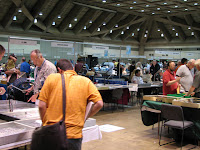 It is still an awe inspiring experience to walk into the hall and see wall-to-wall dealer tables. Adding to the depth of vision was the framing that Whitman used during the last show behind the tables to allow dealers to hang banners. As I began to walk to the left side of Hall A, I noticed that Whitman placed stickers on the floor to mark the row numbers. Looking up, on the columns, they also placed numbered signs showing row numbers and the table number group. The best way I can describe this is that the numbers resemble address numbers on street signs. It is a small touch, but when looking for a specific dealer it really helps.
It is still an awe inspiring experience to walk into the hall and see wall-to-wall dealer tables. Adding to the depth of vision was the framing that Whitman used during the last show behind the tables to allow dealers to hang banners. As I began to walk to the left side of Hall A, I noticed that Whitman placed stickers on the floor to mark the row numbers. Looking up, on the columns, they also placed numbered signs showing row numbers and the table number group. The best way I can describe this is that the numbers resemble address numbers on street signs. It is a small touch, but when looking for a specific dealer it really helps.

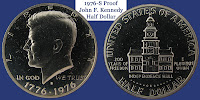 I saw a number of dealers I have bought from and spoken with in the past. Of note I was able to speak with Wayne Herndon, author of the last-page article in July’s Numismatist. The article is really good dry, tongue-in-cheek humor that I found fit Wayne’s personality when you talk with him. Wayne is a good guy and a very fair dealer. From Wayne, I was able to find some 1976 coins that I want to submit to NGC for the registry set. Finding really nice Eisenhower Dollars is very difficult, but Wayne had this 1976-D Type 1 Dollar that I could not pass up. Amongst the other coins I bought was a 1976-S Proof JFK Half Dollar is beautiful.
I saw a number of dealers I have bought from and spoken with in the past. Of note I was able to speak with Wayne Herndon, author of the last-page article in July’s Numismatist. The article is really good dry, tongue-in-cheek humor that I found fit Wayne’s personality when you talk with him. Wayne is a good guy and a very fair dealer. From Wayne, I was able to find some 1976 coins that I want to submit to NGC for the registry set. Finding really nice Eisenhower Dollars is very difficult, but Wayne had this 1976-D Type 1 Dollar that I could not pass up. Amongst the other coins I bought was a 1976-S Proof JFK Half Dollar is beautiful.
Watch out NGC, these coins (and other coins) will be sent this week!
One thing I noticed was that there was a lot of table sharing. While this is a common practice with small dealers, there were some higher volume dealers sharing tables, especially on the corners. For the buyer, this meant that there were more options. I was able to pickup some nice items while junk box diving for resale that I will be posting on eBay soon. Yes, there were some nice items in many of the junk boxes which was surprising.
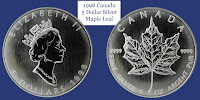 I also had taken the opportunity to try to complete my set of Silver Maple Leaf coins. I was able to find a 1989, 1992, 1996, and 1998. All I am missing from the set is 1990 and 2007. I forgot about the 2007 and did not buy one at the show. All are beautiful coins, but the 1998 is the best. Images of these coins are difficult, but I tried so I can show off their beauty.
I also had taken the opportunity to try to complete my set of Silver Maple Leaf coins. I was able to find a 1989, 1992, 1996, and 1998. All I am missing from the set is 1990 and 2007. I forgot about the 2007 and did not buy one at the show. All are beautiful coins, but the 1998 is the best. Images of these coins are difficult, but I tried so I can show off their beauty.
 As I complete many of my United States sets, I am looking for other areas to explore. One area of interest is the currency of Israel. Coins are interesting, but the Israeli paper is beautiful with nice historical images. But first, I wanted the 2005 Theory of Relativity Commemorative Proof. I purchased a beautiful proof coin from noted dealer in Israeli Numismatics, J.J. van Grover. Van Grover is also the Vice President of the American Israel Numismatic Association, an organization which I recently joined, and we had a chance to talk about AINA and other Israeli issues. But the coin is beautiful whose image cannot do it justice.
As I complete many of my United States sets, I am looking for other areas to explore. One area of interest is the currency of Israel. Coins are interesting, but the Israeli paper is beautiful with nice historical images. But first, I wanted the 2005 Theory of Relativity Commemorative Proof. I purchased a beautiful proof coin from noted dealer in Israeli Numismatics, J.J. van Grover. Van Grover is also the Vice President of the American Israel Numismatic Association, an organization which I recently joined, and we had a chance to talk about AINA and other Israeli issues. But the coin is beautiful whose image cannot do it justice.
I did buy some Israeli paper money. These two notes are from the Fourth Series Pounds dated 1973 but issued in 1975. These notes were demonetized in 1983.
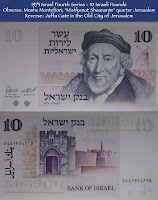

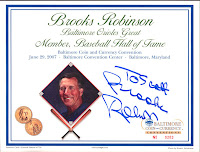 Before going through the rest of the show floor, it was time to take a pause to do something non-numismatic. Appearing at the show was Baltimore Orioles Great and Member of the Baseball Hall of Fame, Brooks Robinson. Robinson is a very gracious gentleman whose current wrist injury he blames on old age. At 70, he may not be able to defend the hot corner but he is not ready for the home either. I did stand on line for his autograph and have my picture taken. Even though my Mets beat his Orioles in 1969, I cannot deny that he was a great player and a classy person. It was a joy to meet him.
Before going through the rest of the show floor, it was time to take a pause to do something non-numismatic. Appearing at the show was Baltimore Orioles Great and Member of the Baseball Hall of Fame, Brooks Robinson. Robinson is a very gracious gentleman whose current wrist injury he blames on old age. At 70, he may not be able to defend the hot corner but he is not ready for the home either. I did stand on line for his autograph and have my picture taken. Even though my Mets beat his Orioles in 1969, I cannot deny that he was a great player and a classy person. It was a joy to meet him.
 Before returning to the bourse floor, I stopped at the nearby Whitman booth. During registration, we were given a coupon for a free copy to The Expert’s Guide to Collecting & Investing in Rare Coins, the latest tome from Q. David Bowers, with a $25 purchase. I almost walked away from the booth before noticing Whitman was selling something that was not numismatic or philatelic related. Whitman now creates something called Football Vault Books. With the publisher from the south, it is not surprising that the series started to cover the Southeastern Conference. When I found the University of Georgia Vault Book I decided to use my coupon after buying the book. The Vault Book is fantastic! It has the history and reproduction of memorabilia from the era being discussed. Ok… back to the coins.
Before returning to the bourse floor, I stopped at the nearby Whitman booth. During registration, we were given a coupon for a free copy to The Expert’s Guide to Collecting & Investing in Rare Coins, the latest tome from Q. David Bowers, with a $25 purchase. I almost walked away from the booth before noticing Whitman was selling something that was not numismatic or philatelic related. Whitman now creates something called Football Vault Books. With the publisher from the south, it is not surprising that the series started to cover the Southeastern Conference. When I found the University of Georgia Vault Book I decided to use my coupon after buying the book. The Vault Book is fantastic! It has the history and reproduction of memorabilia from the era being discussed. Ok… back to the coins.
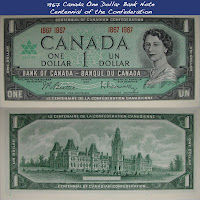 This time, the foreign section was smaller than usual. I was looking for some Canadian coins but was a little disappointed at the selection and the lack of dealers with good Canadian inventory. Rather than walk away empty handed, I bought a 1967 Centennial of the Confederation One Dollar note. It is a crisp, uncirculated note that has a look very reminiscent of the formal aspects of the 1960’s.
This time, the foreign section was smaller than usual. I was looking for some Canadian coins but was a little disappointed at the selection and the lack of dealers with good Canadian inventory. Rather than walk away empty handed, I bought a 1967 Centennial of the Confederation One Dollar note. It is a crisp, uncirculated note that has a look very reminiscent of the formal aspects of the 1960’s.
 As the day was winding down, I needed to buy something old. Somebody had to have something not that expensive but old and fun. I happened upon the table for The Butternut Company out of Clifton, Virginia. Butternut has a nice business of Civil War memorabilia along with the coins. But the had a junk box of well worn large and half cents. Ah ha! Something old! So I searched the small box looking for something with a readable date. In the box I found an 1803 Large Cent that satisfied my old and fun criteria. It is 204 years old and is just loaded with history.
As the day was winding down, I needed to buy something old. Somebody had to have something not that expensive but old and fun. I happened upon the table for The Butternut Company out of Clifton, Virginia. Butternut has a nice business of Civil War memorabilia along with the coins. But the had a junk box of well worn large and half cents. Ah ha! Something old! So I searched the small box looking for something with a readable date. In the box I found an 1803 Large Cent that satisfied my old and fun criteria. It is 204 years old and is just loaded with history.
As I left with ten minutes to closing, dealers were already closing down and vacating. I walked through the Sheraton, purchased a beverage and candy bar from the hotel shop, and retrieved my car from their lot. I left driving around traffic on their way to an Orioles game and found my way to I-395 to head back to the Washington, DC area. During the trip I called my wife to discuss dinner plans and made good time going south on I-95 to the Capital Beltway. I picked up something for dinner and headed home. After being happily greeted by Boomer, I cleaned up and served dinner while telling my wife about the fun I had. Show-and-tell occurred before desert.
In all, it was a wonderful day and a wonderful show.
Click on any image to enlarge. Vault Book cover from Whitman Publishing.
Apr 7, 2007 | coins, personal
My Uncle Bill died this past week, succumbing to the pancreatic cancer that he fought for the last year. His funeral was last Monday. Aside from being the patriarch of the family, he was a consummate teller of corny jokes, offerer of simple and sage advice, and an avid stamp collector. Although he gave up his philatelic endeavors a few years ago, he had a good sense for collecting. Uncle Bill was an inspiration for aspects of how I work with my current collection.
A few years ago, I hosted Thanksgiving dinner at my home. I spend the few days prior preparing and cooking for the few who avail themselves of my invitation for a home cooked Thanksgiving that includes my chestnut stuffing, which always gets rave reviews. While in my home, I showed Uncle Bill the row of Whitman Folders with my coins and the few albums I had. He noticed the age of the Whitman Deluxe album with the Roosevelt Dimes and suggested that I replace the album with a newer one and the folders for albums. Aside from updating to more archival quality materials, the albums will allow the viewing of both sides of the coins.
One thing I had not counted on was the toning from the older album. While looking at the dimes, Uncle Bill pointed out the album toning on a few coins. After the holiday weekend I purchased Whitman Classic albums, transferred the coins, and replaced the album toned coins. Then I systematically purchased Whitman Classic albums to replace the folders. With some exceptions, all of the folders have been replaced with albums.
It was Uncle Bill’s simple and sage advice that has improved the presentation and enjoyment of this hobby of kings. Thank you, Uncle Bill. Thank you for the advice. Thank you for all of the corny jokes. Thank you for your love and support. Thank you for improving the lives of all around you.
 Through this long history, The Saturday Evening Post continues to publish a variety of stories including those of general interest. One of The Post’s regular columns is “Collectible News & Notes.” As part of the column, The Post features a collector and their passion for what they collect. In the July/August 2010 issue (Vol. 283, No. 4), your blog host is the featured collector.
Through this long history, The Saturday Evening Post continues to publish a variety of stories including those of general interest. One of The Post’s regular columns is “Collectible News & Notes.” As part of the column, The Post features a collector and their passion for what they collect. In the July/August 2010 issue (Vol. 283, No. 4), your blog host is the featured collector.















